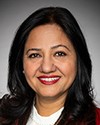Thank you so much.
We're now going to turn to Sonia Sidhu online.
Sonia, you have the floor for six minutes.
Evidence of meeting #48 for Status of Women in the 44th Parliament, 1st Session. (The original version is on Parliament’s site, as are the minutes.) The winning word was athletes.
A recording is available from Parliament.
5:15 p.m.
Conservative

The Chair Conservative Karen Vecchio
Thank you so much.
We're now going to turn to Sonia Sidhu online.
Sonia, you have the floor for six minutes.
5:15 p.m.
Liberal

Sonia Sidhu Liberal Brampton South, ON
Thank you, Madam Chair.
Thank you to all of the witnesses for your testimony and for sharing your lived experience. It is heartbreaking. I want to thank you for your bravery and for adding to your important work so that we can all build a safer sports environment in Canada for women and girls.
My first question is for Ms. Proske from AthletesCAN. You spoke about having a moral compass and Olympic dreams. We want both to be a reality.
How does AthletesCAN support athletes who have come forward with complaints of misconduct in sport, and what resources are provided?
5:15 p.m.
Vice-President, AthletesCAN
At AthletesCAN, our job is to amplify. For those who may not be aware, AthletesCAN is an independent non-profit. We are run by athletes, for athletes. We represent the 64 national teams. We just see our job as being a unified place to amplify that.
We have had a hand in doing pulse checks with our athletes for a long time. In 2019, we ran a safe sport summit.
My apologies for referencing my notes; I do have a bit of a Swiss cheese brain.
We passed the seven key consensus findings on to Sport Canada. That resulted in a provincial and federal summit. Eventually it went down the line to the UCCMS and OSIC. We did a pulse check last year as well.
We're really excited. I see our job as directing people to the many resources that there are and making sure there are no gaps. We're working on an athlete hub as well, to have a one-stop shop because athletes should be focused on their important work, which is being heads-down and being the best athlete that they possibly can be. It shouldn't be their job to be on top of all of the minutia of governmental and policy change.
5:15 p.m.
Liberal

Sonia Sidhu Liberal Brampton South, ON
As a follow-up, you talked about OSIC services and funding accountability.
Do you believe that OSIC is an essential mechanism for athletes? How does it force national sport organizations to adopt...?
5:20 p.m.
Vice-President, AthletesCAN
As someone who made a career out of being first at the finish line, I'm eager for this to be fully developed to where I know it can be. It's only six months old. I'm really excited to see what will happen when everyone signs on in April.
I do wish that we had these services a long time ago. I know that it's not perfect. I would love to see OSIC's powers expanded at the provincial and local levels. I think it's far from perfect at the moment.
5:20 p.m.
Liberal

Sonia Sidhu Liberal Brampton South, ON
Thank you.
My next questions are for Ms. O'Neill from the Canadian Paralympic Committee.
You talked about safe and inclusive sport. Can you describe your approach to working with and supporting athletes who have disabilities? How does this impact their experiences in sport?
5:20 p.m.
Chief Executive Officer, Canadian Paralympic Committee
Sure.
I'll start off and then perhaps ask Erica to give an athlete's perspective.
I would say that we see a fundamental, strong link between diversity and inclusion and safe sport. If you are able to address what a safe, welcoming and inclusive environment looks like, then you will probably reduce your chances of harm and maltreatment. We believe that they're inextricably linked.
As a games organization, we organize and support, on behalf of Canada, the Canadian Paralympic team for three sets of games every four years. These are the Parapan team, the summer Paralympic team and the winter Paralympic team.
From an organizational standpoint, we would be scrubbing down on all the details during a games period of, for instance, how athletes are prepared through our sport members and in partnership with our sport members before they even go to the games. That's especially for those where it might be their first time heading to the games and their first games experience.
In the village, there are built-in support structures to ensure that the sport managers, athletes and sport-specific teams are well taken care of and that they have a response mechanism should anything be required immediately. Also, at a very fundamental level, even with the number of people, there's room allocation and linkage with the staff.
Erica can perhaps comment from an athlete's perspective and experience.
5:20 p.m.
Erica Gavel Ph.D. candidate and Vice-Chair, Canadian Paralympic Committee Athlete Council, Canadian Paralympic Committee
I'm very much in agreement with Karen's comments.
I think one of the biggest differences when you're comparing able-bodied athletes with para athletes is just understanding that there really is a disability component.
People end up in sport, and para sport in particular, through different avenues. I'm going to assume that someone with a congenital disability is going to have a different sport upbringing, perhaps, than someone with an impairment acquired later on in life.
From an athlete's perspective—I'm just speaking from my own perspective right now—a safe and inclusive environment just allows the athlete to feel comfortable being who they truly are.
I just think that para sport is so dynamic. Even from the coaching aspect, everything is very different from able-bodied....
5:20 p.m.
Liberal

Sonia Sidhu Liberal Brampton South, ON
Thank you.
How can we make sure that access to inclusive mental health professionals for athletes can be expanded? What do athletes need, especially athletes living with disabilities—or any athlete who needs those services? How we can expand access to them?
5:20 p.m.
Conservative
5:20 p.m.
Chief Executive Officer, Canadian Paralympic Committee
I'm going to ask Michelle to respond to that question, particularly on the mental health support services available.
5:20 p.m.
Michelle Killins Director, Paralympic Performance and Pathways, Canadian Paralympic Committee
Thank you for that.
We do have a mental health lead within our organization because we recognize that there are quite a few gaps in our para population's ability to access mental health services. We don't know all of the reasons why. We're actually looking into developing some research and talking to our athletes to better understand what some of the gaps are to accessing mental health services so that we can better create programming for them.
5:20 p.m.
Conservative

The Chair Conservative Karen Vecchio
Thank you so much.
We're now going to turn it over to Andréanne Larouche.
Andréanne, you have six minutes.
5:20 p.m.
Bloc

Andréanne Larouche Bloc Shefford, QC
Thank you very much, Madam Chair.
I'd like to thank Ms. Proske, Ms. O'Neill, Ms. Killins, Ms. Gravel and Mr. El‑Awadi for their testimony today, which complements our important study on women in sport.
Ms. Proske, can you explain where your funding comes from?
5:25 p.m.
Vice-President, AthletesCAN
We are funded through Sport Canada, but we are a completely independent organization.
5:25 p.m.
Bloc

Andréanne Larouche Bloc Shefford, QC
Okay.
I'll now turn to Mr. El‑Awadi from Swimming Canada.
Mr. El‑Awadi, how much does it cost you annually to be part of the Office of the Sport Integrity Commissioner, or OSIC, program? Also, what does the agreement cover?
5:25 p.m.
Chief Executive Officer, Swimming Canada
I'm sorry, but I can't hear the interpretation.
5:25 p.m.
Bloc
5:25 p.m.
Chief Executive Officer, Swimming Canada
For us, at the national level, it's about $20,000. The amount increases as you include the provincial and municipal levels.
5:25 p.m.
Bloc
5:25 p.m.
Chief Executive Officer, Swimming Canada
It includes all volunteers, athletes, staff, and coaches associated with our national team, from entry to the Olympic and Paralympic levels.
5:25 p.m.
Chief Executive Officer, Swimming Canada
We receive about $6 million from governments. Most of the money comes from the federal government, but the provincial governments also contribute, depending on the event. It's mostly registrations and other revenue generated through corporate partnerships.